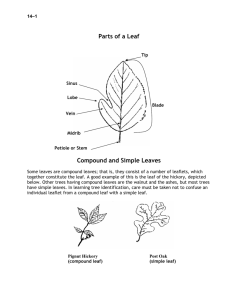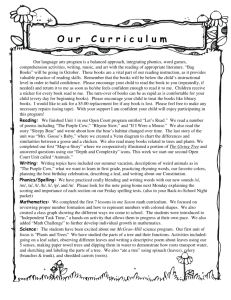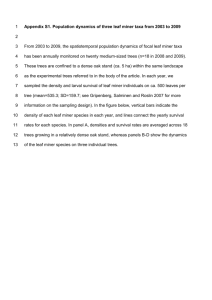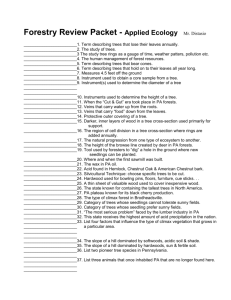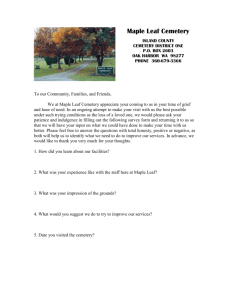FOR-65: Tree Tips - UK College of Agriculture
advertisement
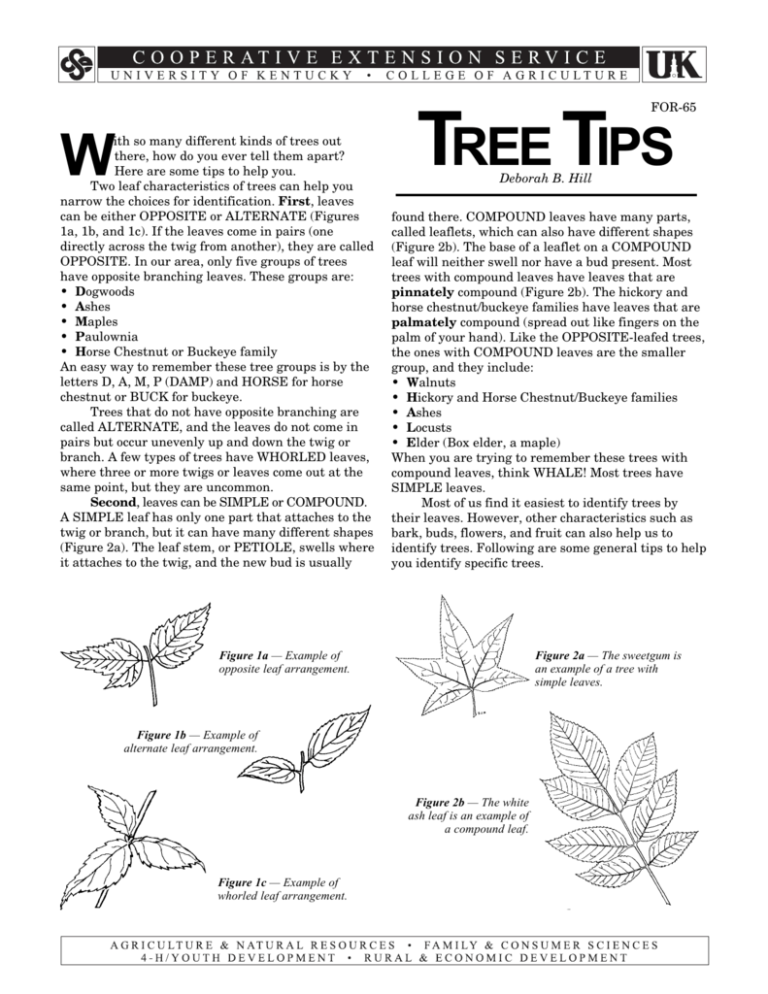
FOR-65 W ith so many different kinds of trees out there, how do you ever tell them apart? Here are some tips to help you. Two leaf characteristics of trees can help you narrow the choices for identification. First, leaves can be either OPPOSITE or ALTERNATE (Figures 1a, 1b, and 1c). If the leaves come in pairs (one directly across the twig from another), they are called OPPOSITE. In our area, only five groups of trees have opposite branching leaves. These groups are: • Dogwoods • Ashes • Maples • Paulownia • Horse Chestnut or Buckeye family An easy way to remember these tree groups is by the letters D, A, M, P (DAMP) and HORSE for horse chestnut or BUCK for buckeye. Trees that do not have opposite branching are called ALTERNATE, and the leaves do not come in pairs but occur unevenly up and down the twig or branch. A few types of trees have WHORLED leaves, where three or more twigs or leaves come out at the same point, but they are uncommon. Second, leaves can be SIMPLE or COMPOUND. A SIMPLE leaf has only one part that attaches to the twig or branch, but it can have many different shapes (Figure 2a). The leaf stem, or PETIOLE, swells where it attaches to the twig, and the new bud is usually TREE TIPS Deborah B. Hill found there. COMPOUND leaves have many parts, called leaflets, which can also have different shapes (Figure 2b). The base of a leaflet on a COMPOUND leaf will neither swell nor have a bud present. Most trees with compound leaves have leaves that are pinnately compound (Figure 2b). The hickory and horse chestnut/buckeye families have leaves that are palmately compound (spread out like fingers on the palm of your hand). Like the OPPOSITE-leafed trees, the ones with COMPOUND leaves are the smaller group, and they include: • Walnuts • Hickory and Horse Chestnut/Buckeye families • Ashes • Locusts • Elder (Box elder, a maple) When you are trying to remember these trees with compound leaves, think WHALE! Most trees have SIMPLE leaves. Most of us find it easiest to identify trees by their leaves. However, other characteristics such as bark, buds, flowers, and fruit can also help us to identify trees. Following are some general tips to help you identify specific trees. Figure 1a — Example of opposite leaf arrangement. Figure 2a — The sweetgum is an example of a tree with simple leaves. Figure 1b — Example of alternate leaf arrangement. Figure 2b — The white ash leaf is an example of a compound leaf. Figure 1c — Example of whorled leaf arrangement. Bark • Yellow-poplar bark has gray ridges with chalky white in the valleys between the ridges. These trees usually grow very straight and tall. • Dogwood has bark that cracks into little tiny pieces and looks like alligator skin. • Older cherry trees have black bark that breaks up and curls, looking like burnt potato chips. Young trees have smooth, dark bark with many small horizontal openings (slits) called LENTICELS. • Sycamore trees have bark that peels off high on the trunk, leaving behind big whitish or light green patches that look like camouflage clothing. • The bark of box elder on the branches and twigs is very green. • Shagbark hickory has big strips of bark peeling off, which makes it easy to recognize. • The bark of the hackberry has warts all over it. tips. The American Indians were called red men; they shot arrows, which have very pointed tips. SO the white oak group has rounded tips on its leaves, and the red oak group has pointed tips on its leaves (Figure 5a and Figure 5b). Figure 5a — The post oak is from the white oak group. Buds • Bitternut hickory has buds that are bright-yellow, fuzzy, and slender, not fat like other hickory buds (Figure 3). • American beech trees have long, skinny, cigar-shaped brown buds. • American basswood has single, round, fat, reddish buds that are set lopsided to branch or twig. • Yellow-poplar has buds that look like a pair of praying hands. Figure 3 — Bitternut hickory bud. Leaves • American beech leaves are very thin and smooth and feel like paper. • Paw paw has big leaves (almost 12 inches long) that look like eagle feathers. They smell like green pepper when you crush them. • Dogwood leaves have veins that curve all the way around to the tip (Figure 4). No other tree species has veins like that. • There are two groups of oaks (there are many kinds of individual oaks). These two groups are known as the red oaks and the white oaks. Try to remember cowboys and Indians. Historically, most cowboys were called white men; they shot Figure 4 — The bullets, which have rounded dogwood leaf. 2 Figure 5b — The pin oak is from the red oak group. • Redbud trees have heart-shaped leaves. Think heart - red - redbud. • Slippery elm leaves are very fuzzy — almost like sandpaper — on both sides. American elm has fuzzy leaves, too, but not so much as slippery elm. • Sugar maple has SINUSES (spaces between lobes) that are U-shaped, and the actual edge of the leaf is smooth. Red maple has V-shaped sinuses, and the edge of the leaf is SERRATED, or toothed (Figure 6a and Figure 6b). Figure 6a — Note the U-shaped SINUSES of the sugar maple leaf. Figure 6b — The SINUSES of the red maple leaf are V-shaped. • Black gum, or tupelo, has shiny dark green leaves, smooth on the surface and smooth on the edge. The leaf comes to a long narrow tip — a drip tip. The branches come straight out from the tree at right angles. • Cherry trees also have dark green, shiny leaves, but they are basically a long oval shape, and they have tiny teeth along the edge. Many times there will be a tiny gland or wart on the petiole of the leaf, just below the leaf base. When you crush the leaf or pull a stem off a branch, it has a very sharp odor. • Sassafras has three different leaf shapes. One is oval, one has a notch in one side, “mitten,” and one has two notches, one on either side, “fork” (Figure 7). Sassafras also has a strong but pleasant odor, and its leaves are smooth. • Mulberry has two different leaf shapes — one a simple ovate leaf, the other with one or more lobes, similar to sassafras. Mulberry has no distinct odor, and its leaves are thin and fuzzy. • Box elder is the only maple tree that has a compound leaf. Some people call it ash-leafed maple because the leaf looks like an ash leaf. • Sycamore tree leaves look a lot like maple leaves, but sycamores have fruit that looks like a ball. • White pine is the only pine in this region that has five needles in each bundle, or FASCICLE. Our other pines have two or three needles in each bundle. • Sweetgum has a star-shaped leaf (Figure 2a). • The walnuts have compound leaves. Black walnut often does not have a leaflet at the very end of the leaf; white walnut, or butternut, almost always does. If you cut into a twig or branch the long way at its center, you will see the PITH. In a butternut the pith is chocolate brown; in black walnut it is light brown or buff-colored. • There are three native magnolia trees in our forests: big-leaf magnolia, umbrella magnolia, and cucumber tree. Both big-leaf and umbrella magnolia have very large leaves (longer than 12 inches), but you can tell them apart by the base of the leaf. On big-leaf there are two lobes that extend back toward the petiole — if you look at it from the side, these two little lobes look like the bulges of a “B.” Umbrella magnolia leaves have no lobes at their bases. Both big-leaf and umbrella magnolia leaves are broader at the tip than at the base. Cucumber tree, on the other hand, has leaves that are generally more oval or are broader closer to their bases. • Kentucky coffeetree has doubly pinnately compound leaves (17 to 30 inches long with three to eight side forks). The leaflets are basically oval in shape and are smooth edged. Fruit/Seed • Sweetgum trees have lots of prickly gum balls lying around on the ground near them and hanging on the branches after the leaves drop (Figure 8). • Maple and ash seeds are SAMARAS (“helicopters”). Maple seeds are in pairs and may also be clustered in a big group. Ash seeds are in large clusters and usually fall off as single “helicopters” and not as pairs. Figure 8 — This prickly ball is the fruit of the sweetgum. Figure 7 — An example of the three different leaf shapes of the sassafras. 3 Flowers • Yellow-poplar has orange-yellow flowers that look like tulips (Figure 9). • Basswood has small clusters of flowers and fruit that come out of the middle of leaf like BRACTS that are 2 to 3 inches long. The flowers are very sweet smelling and make an excellent nectar source for honeybees. Figure 9 — The flower • Black locust has small pea- of the yellow-poplar shaped white flowers that looks like a tulip. appear in hanging clusters 4 to 8 inches long. They are very fragrant and are also good for bee forage. • Horse chestnut has small white flowers with either a yellow or a red-spotted base. Flowers occur in upright clusters. Other Characteristics • Honey locust trees have BIG thorns on them, usually with two or more side branches or prongs (Figure 10). Black locust has tiny thorns that usually occur at the leaf bases. Figure 10 — The large thorns of the honey locust are a distinguishing feature. For more detailed information on identifying trees, consult a tree guide or Extension publication FOR-1, Kentucky’s Forest Trees and How To Know Them. Educational programs of the Kentucky Cooperative Extension Service serve all people regardless of race, color, age, sex, religion, disability, or national origin. Issued in furtherance of Cooperative Extension work, Acts of May 8 and June 30, 1914, in cooperation with the U.S. Department of Agriculture, C. Oran Little, Director of Cooperative Extension Service, University of Kentucky College of Agriculture, Lexington, and Kentucky State University, Frankfort. Copyright © 1999 for materials developed by the University of Kentucky Cooperative Extension Service. This publication may be reproduced in portions or its entirety for educational or nonprofit purposes only. Permitted users shall give credit to the author(s) and include this copyright notice. Publications are also available on the World Wide Web at: http://www.ca.uky.edu. Issued 7-1994, Revised 10-1999, Last printed 10-1999, 2000 copies, 9000 copies to date.
